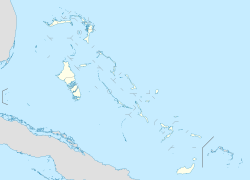This article needs additional citations for verification. (July 2009) |
Freeport | |
|---|---|
City | |
| City of Freeport | |
 | |
| Nicknames: The Industrial Capital The Second City | |
 The city of Freeport highlighted in red in Bahamas | |
| Coordinates: 26°31′43″N 78°41′48″W / 26.52861°N 78.69667°W | |
| Country | |
| Island | Grand Bahama |
| District | City of Freeport |
| Established | August 4, 1955 |
| Government | |
| • Type | District Council |
| • Chief Councillor | Kendal Culmer |
| • Deputy Chief Councillor | Ernie Barr |
| Area | |
| • City | 558 km2 (215 sq mi) |
| Elevation | 10 m (30 ft) |
| Population (2000) | |
| • City | 26,914 |
| • Density | 48/km2 (125/sq mi) |
| • Metro | 55,500 |
| Time zone | UTC-5 (Eastern Time Zone) |
| Area code | 242 |
| IATA airport code | FPO |
| ICAO airport code | MYGF |
| Website | http://gbpa.com/home/ |
Freeport is a city, district and free trade zone on the island of Grand Bahama of the northwest part of The Bahamas. In 1955, Wallace Groves, a Virginian financier with lumber interests in Grand Bahama, was granted 20,000 hectares (50,000 acres) of pineyard with substantial areas of swamp and scrubland by the Bahamian government with a mandate to economically develop the area. Freeport has grown to become the second most populous city in The Bahamas.
The main airport serving the city is the Grand Bahama International Airport, which receives domestic flights from various islands of The Bahamas as well as several international flights from the United States, Italy, and Canada. Freeport is also served by domestic Bahamian ferry services to other islands, and an international ferry connection to Miami.
The Grand Bahama Port Authority (GBPA) operates the free trade zone, under the Hawksbill Creek Agreement signed in August 1955 whereby the Bahamian government agreed that businesses located in the Freeport area would pay no taxes before 1980, later extended to 2054.[1] The area of the land grants within which the Hawksbill Creek Agreement applies has been increased to 56,000 hectares (138,000 acres).[2]
- ^ Blount, Steve. "Freeport, Bahamas". USA Today. Retrieved 8 January 2014.
- ^ "Freeport Grand Bahama". Government of the Bahamas. 25 October 2023.
